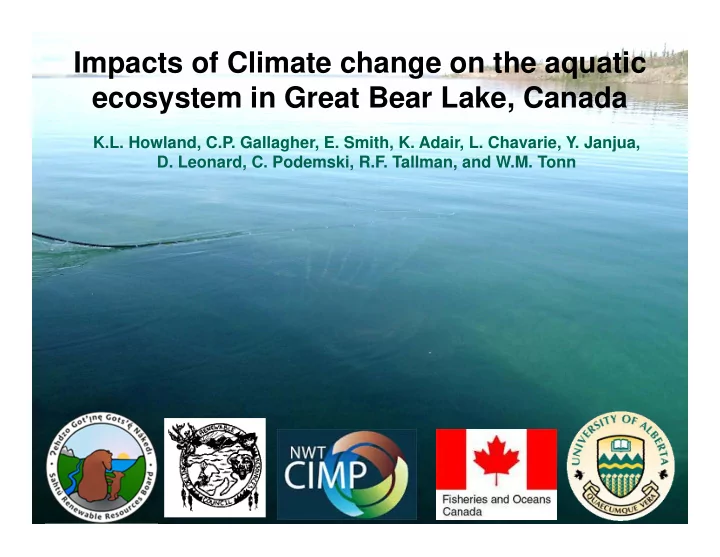

Impacts of Climate change on the aquatic ecosystem in Great Bear Lake, Canada K.L. Howland, C.P. Gallagher, E. Smith, K. Adair, L. Chavarie, Y. Janjua, D. Leonard, C. Podemski, R.F. Tallman, and W.M. Tonn
3 2 1 CANADA 4 ALASKA 2
Great Bear Lodge Trophy Lodge Great Bear Lake Neiland Bay Lodge Grey Goose Lodge/ Subsistence Fishing Deline Mine exploration site Great Bear River Mine remediation site
Local Fisheries ‐ Traditional Ecological Knowledge Environment, human uses and related stressors Stressor GBL Climate change Major / Change in Ice Free period (almost 3 weeks in 30 years) No direct major impact on fisheries yet No Water level No, Well Controlled Pollution / Water quality No, not now Mining No Commercial fisheries Minor (C&R) Sport fisheries No Tourism No Transport (Janjua et al., unpublished)
Objectives 1. Address knowledge gaps regarding the Great Bear Lake ecosystem and the relationships of different ecosystem components to fisheries production Water quality • • Benthic invertebrates • Zooplankton Nearshore terrestrial invertebrates • 2. Establish community-based monitoring sites near Déline to assess seasonal and annual changes in water quality and invertebrate indicators 3. Assess impacts of climate change on Great Bear Lake ecosystem and possible effects on harvested fish
Methods ‐ Study Area Tugacho (Dease Arm) 2015 Tirato Sahtu (Smith Arm) Kwit la (Great Bear 2016 (McTavish Arm) Lake) 2014 Tirato Turili (Keith Arm) McVicar Arm 2012 2013
Methods ‐ Ecosystem Sampling Design Inshore (0 ‐ 2 m) Pelagic ‐ profundal Pelagic ‐ profundal Pelagic ‐ deep (21 ‐ 50 m) (51 ‐ 100 m) profundal (100+ m) Littoral (3 ‐ 20 m) McVicar Arm (2013)
Depth Water Zooplankton Benthic Inverts Fishing Zone quality (plankton net) (Kick, Ponar grab) (gill nets) 0-2 m Seine only 3-20 m Bottom 21-50 m Bottom/ Surface 51-100 m Bottom/ Mid/ Surface 100+ m Bottom/ Mid/ Surface Composition, Temp, Chl a , DO, pH, Composition, Composition, Abundance, Abundance, Biomass Tubidity, Conductivity Abundance, Biomass Biomass, Demographics
Community ‐ based monitoring sites Off shore (60 m depth) temperature array; zooplankton; benthic invertebrates Nearshore benthic/ terrestrial invertebrates Deline X Keith Arm
Water Quality (temperature) Keith Arm (2012) McVicar Arm (2013) Epilimnion 0 ‐ 2 m 3 ‐ 20 m Metalimnion 21 ‐ 50 m 51 ‐ 100 m Hypolimnion 100+ m
Water Quality ‐ Thermocline (Johnson 1975 JFRBC)
Water Quality (chlorophyll a) Keith Arm (2012) McVicar Arm (2013) Epilimnion 0 ‐ 2 m 3 ‐ 20 m Metalimnion Metalimnion 21 ‐ 50 m 51 ‐ 100 m Hypolimnion 100+ m
Zooplankton Densities by Depth Leptodiaptomus sicilis Limnocalanus macrurus X Senecella calaniodes Daphnia sp. Species composition similar to earlier studies on Great Bear lake
Benthic invertebrate community composition Keith Arm 2012 Kick Net Ponar Grab 100 90 80 Average frequency (%) Platyhelminthes 70 Nematoda 60 Annelida 50 Mollusca Malacostraca 40 Copepoda 30 Ostracoda Arachnida 20 Insecta 10 0 Red (0-2 m) Yellow (3-20 m) Green (21-50 m) Purple (50-100 m) Blue (>100 m) Sampling strata
Benthic invertebrate diversity Keith Arm 2012 45 Kick Net Ponar Grab Number of taxonomic groups in a sample 40 35 30 25 20 15 10 5 0 Red (0-2 m) Yellow (3-20 m) Green (21-50 m) Purple (51-100 m) Blue (100+ m) Sampling strata
Benthic invertebrate abundance Keith Arm 2012 1000 Kick Net Ponar Grab Number of aquatic invertebrates in a sample 900 800 700 600 500 400 300 200 100 0 Red (0-2 m) Yellow (3-20 m) Green (21-50 m) Purple (51-100 m) Blue (100+ m) Sampling strata
Summary • Sampling of invertebrates show variation in abundance by depth and distance from shore • Preliminary results on water quality and other ecosystem components suggest shifts towards increased temperatures, stratification and possibly increased production at lower trophic levels over last 50 y climate related? need for continued monitoring to look at spatial and interannual variability
Further work • Complete sorting and identification: zooplankton, 2013 benthic invertebrates • Examine patterns in distribution, abundance, demographics of fish, invertebrates > relationship to each other, abiotic variables, historical data ‐ changes over time • Investigate possibility of use of coring to reconstruct past changes in lake temperature and productivity • Data will contribute to ecosystem and fish population models as it becomes available. • Years 1 and 2 completed in a 5 year cycle: o Continue in McTavish Arm (summer 2014) o Continue seasonally comprehensive community ‐ based monitoring close to Deline
Thank You! Mahsi Cho! • NWT Cumulative Impacts Monitoring Program • Sahtu Renewable Resources Board • Deline Renewable Resources Council • Deline Lands and Finance Corporation • GNWT Renewable Resources Deline • DFO Hay River, Yellowknife & Inuvik • Polar Continental Shelf Project • Natural Sciences and Engineering Research Council • Canadian Circumpolar Institute • Traditional Knowledge, Deline: Paul Modeste, Douglas Baton, John Tutcho, George Kenny, Morrıs Modeste, Joseph Blondın, Jr., and Alfred Tanıton; community researchers Michael Neyelle & Mavis Baton • Field Work 2012: Deline -Darren Kenny, Bobby Modeste, Allison Tatti, Gerald Tutcho, Archie Vitale; DFO Winnipeg - Dave Boguski, Kristin Hynes • Field Work 2013: Deline –Chris Yukon, Archie Vitale, Allison Tatti, Morris Betsidea, Isodore Betsidea; DFO Winnipeg - Kristen Adair • Invertebrate analyses: Erica Smith & Lyla Witschi
Recommend
More recommend